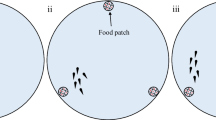Summary
WhenColpidium campylum are put in an observation chamber, they form groups of hundreds or thousands of individuals. In a temperature gradient, these groups find their preferred temperature range within a few hours, whereas isolated individuals can achieve this in min. This difference is caused by the social tendency of these ciliates.
Similar content being viewed by others
References
C. Aylmer and A.H. Reisner, J. gen. Microbiol.67, 57 (1971).
W. Rose, Z. Tierpsychol.21, 257 (1963).
H. Kersken, Verh. dt. zool. Ges.1977, 253.
K. Tawada and H. Miyamoto, J. Protozool.20, 289 (1973).
H. Kersken, in preparation.
Author information
Authors and Affiliations
Additional information
To whom reprint requests should be addressed.
Rights and permissions
About this article
Cite this article
Kersken, H., Laudien, H. Social behaviour versus temperature in the ciliateColpidium campylum. Experientia 35, 1317–1318 (1979). https://doi.org/10.1007/BF01963981
Published:
Issue Date:
DOI: https://doi.org/10.1007/BF01963981




